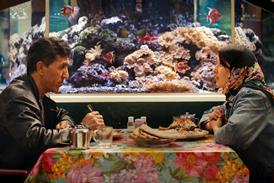Google/YouTube global head of content Robert Kyncl [pictured] talked through the company’s plan to invest in 60 new European channels in a Media Mastermind Keynote at MIPCOM on Monday.
Kyncl told his audience that YouTube’s operations in the UK, France and Germany had “moved from second to third gear and will remain in third gear for a couple of years because that’s what it takes to build big channels… After that we will look to supercharge the channels which have proven the most successful and then it will be full-throttle ahead.”
YouTube announced details of it plans to invest in 60 new European channels — some from well-known producers and celebrities, others from emerging media companies and pioneers in online video — earlier in the day.
The move expands YouTube’s content “catalyser” drive into Europe, following $150m worth of investment in some 100 new US channels last year.
The UK slate includes The Jamie Oliver Food Channel, BBC Worldwide’s nature channel On Earth, dance music specialist Mixmag TV, ITN Productions’ citizen journalist-generated Truthloader and fashion-focused, Carnaby Street-set FASHTAG, a joint venture between Gravity Road and Grazia magazine.
In France, the bouquet features Capa Productions’ celebration of the French capital Rendez-vous à Paris, Kabo Productions’ humour channel FFSK, the family-focused Auféminin La Tribu and Black Dynamite’s Studio Bagel, aimed at budding comedians looking for an online performance space.
German channels included Mutant Boy Entertainment’s Boneless, All About Video’s Happy & Fit, UFA/Fremantle’s Heartbeat Berlin and MV Media’s Motorvision.
According to a report in The Wall Street Journal, Kyncl has $200m to strengthen existing channels and invest in new projects but he did not talk budgets in Monday’s keynote and other Google executives at MIPCOM were equally tight-lipped.
‘We don’t reveal figures but the investment model is simple. It’s an advance on potential future revenue from advertising,” Paris-based Christophe Muller, director of YouTube partnerships in southern Europe, the Middle East and Africa, told Screen.
“Our aim is to act as a catalyser for creation,” he continued. “We’re looking at what we can do as a platform to foster creativity, to enable a creator to get on with the business of creating, without becoming a producer because that’s not our job. We want to remain faithful to the user-generator spirit of YouTube when it was launched seven years ago.”
In his keynote, Kyncl said the move to invest in kick-starting new channels had been made possible by YouTube’s increasing advertising revenues in recent years, which he said were in turn due to the company’s optional advertising policy.
“Users can skip them if they don’t like them. That’s a big deal. When advertisers pay only when ads are watched and when viewers are watching only the ads they care about, advertisers pay more and they don’t care,” he said.
“This means content creators are making more… everyone’s winning. It’s because of this that our system is starting to work,” Kyncl continued. “In the US, we are making as much revenue per hour as cable… and some great brands are coming on board.”
Looking to the future, Kyncl said that anyone involved in content production should be building channels on YouTube.
He noted that the platform, launched in 2007 as an amateur video-sharing site, now distributed four billion hours of content every month to 800 million people around the world.
“The time is now, the moment is ripe to start building your audience on YouTube today,” he concluded.

























No comments yet